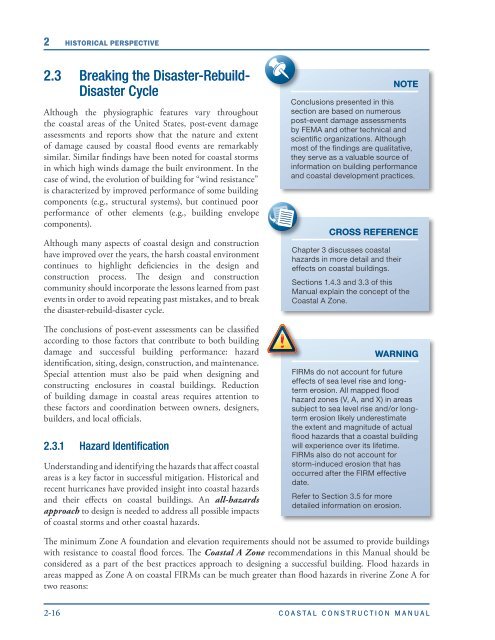Coastal Construction Manual - National Ready Mixed Concrete ...
Coastal Construction Manual - National Ready Mixed Concrete ...
Coastal Construction Manual - National Ready Mixed Concrete ...
Create successful ePaper yourself
Turn your PDF publications into a flip-book with our unique Google optimized e-Paper software.
2 HISTORICAL PERSPECTIVE<br />
2.3 Breaking the Disaster-Rebuild-<br />
Disaster Cycle<br />
Although the physiographic features vary throughout<br />
the coastal areas of the United States, post-event damage<br />
assessments and reports show that the nature and extent<br />
of damage caused by coastal flood events are remarkably<br />
similar. Similar findings have been noted for coastal storms<br />
in which high winds damage the built environment. In the<br />
case of wind, the evolution of building for “wind resistance”<br />
is characterized by improved performance of some building<br />
components (e.g., structural systems), but continued poor<br />
performance of other elements (e.g., building envelope<br />
components).<br />
Although many aspects of coastal design and construction<br />
have improved over the years, the harsh coastal environment<br />
continues to highlight deficiencies in the design and<br />
construction process. The design and construction<br />
community should incorporate the lessons learned from past<br />
events in order to avoid repeating past mistakes, and to break<br />
the disaster-rebuild-disaster cycle.<br />
The conclusions of post-event assessments can be classified<br />
according to those factors that contribute to both building<br />
damage and successful building performance: hazard<br />
identification, siting, design, construction, and maintenance.<br />
Special attention must also be paid when designing and<br />
constructing enclosures in coastal buildings. Reduction<br />
of building damage in coastal areas requires attention to<br />
these factors and coordination between owners, designers,<br />
builders, and local officials.<br />
2.3.1 Hazard Identification<br />
Understanding and identifying the hazards that affect coastal<br />
areas is a key factor in successful mitigation. Historical and<br />
recent hurricanes have provided insight into coastal hazards<br />
and their effects on coastal buildings. An all-hazards<br />
approach to design is needed to address all possible impacts<br />
of coastal storms and other coastal hazards.<br />
NOTE<br />
Conclusions presented in this<br />
section are based on numerous<br />
post-event damage assessments<br />
by FEMA and other technical and<br />
scientific organizations. Although<br />
most of the findings are qualitative,<br />
they serve as a valuable source of<br />
information on building performance<br />
and coastal development practices.<br />
CROSS REFERENCE<br />
Chapter 3 discusses coastal<br />
hazards in more detail and their<br />
effects on coastal buildings.<br />
Sections 1.4.3 and 3.3 of this<br />
<strong>Manual</strong> explain the concept of the<br />
<strong>Coastal</strong> A Zone.<br />
WARNING<br />
FIRMs do not account for future<br />
effects of sea level rise and longterm<br />
erosion. All mapped flood<br />
hazard zones (V, A, and X) in areas<br />
subject to sea level rise and/or longterm<br />
erosion likely underestimate<br />
the extent and magnitude of actual<br />
flood hazards that a coastal building<br />
will experience over its lifetime.<br />
FIRMs also do not account for<br />
storm-induced erosion that has<br />
occurred after the FIRM effective<br />
date.<br />
Refer to Section 3.5 for more<br />
detailed information on erosion.<br />
The minimum Zone A foundation and elevation requirements should not be assumed to provide buildings<br />
with resistance to coastal flood forces. The <strong>Coastal</strong> A Zone recommendations in this <strong>Manual</strong> should be<br />
considered as a part of the best practices approach to designing a successful building. Flood hazards in<br />
areas mapped as Zone A on coastal FIRMs can be much greater than flood hazards in riverine Zone A for<br />
two reasons:<br />
2-16 COASTAL CONSTRUCTION MANUAL







